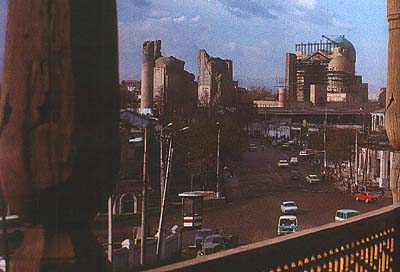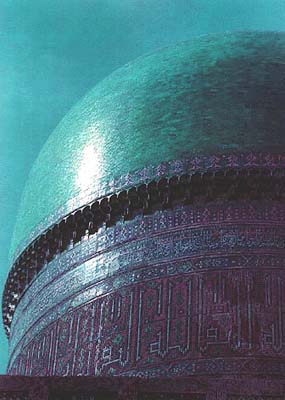From the museum it's a short walk behind the Sher Dor
madrasa, past the Chorsu (a 19th-century vaulted market which now sells
ice cream and secondhand furniture) and down Ulitsa Tashkentskaya to one
of the largest mosques ever built.
According to legend this was the brainchild of Tamerlane's
Chinese chief wife Bibi  Khanym,
who meant to surprise him with a colossal monument on his return from his
1398-99 Indian campaign. Instead he was surprised by a love-bite on her
neck, left there by the mosque's philandering Persian architect. Tamerlane
sent a platoon to seize the adulterer dead or alive, but he fled up one
of the soaring minarets he had just built, leapt off the top and flew home
to Persia.
Khanym,
who meant to surprise him with a colossal monument on his return from his
1398-99 Indian campaign. Instead he was surprised by a love-bite on her
neck, left there by the mosque's philandering Persian architect. Tamerlane
sent a platoon to seize the adulterer dead or alive, but he fled up one
of the soaring minarets he had just built, leapt off the top and flew home
to Persia.
The reality was scarcely less prosaic. The mosque was
Tamerlane's own idea and was to be grander than anything he had seen on
his travels. It was built between 1399 and 1404 by 500 labourers and 95
elephants brought back from India, and 200 architects, artists, master
craftsmen and masons from the rest of the empire. As It neared completion,
Ruy Gonzalez de Clavilo witnessed the infirm emperor throwing coins and
meat to the workmen from his litter to goad them on, 'as one should cast
bones to dogs in a pit'.
An observer wrote of the finished mosque: 'Its dome would
have been unique had it not been for the heavens, and unique would have
been its portal had It not been for fee  Milky
Way.' The portal was nearly 30 m high and the dome even higher. Decorated
with majolica mosaics, carved marble and painted and glided papier mach6,
they stood at the west end of a marble-paved, colonnaded courtyard larger
than a football pitch (130 m by 102 m), with a minaret at each corner.
The main gates opposite the mosque were made of seven different metals
and were flanked by ceramic columns 50 m high. Two minor mosques looked
inward from the north and south towards a giant marble Koran-holder in
which rested the Osman Koran, said to be the second Koran in history, whose
script was so big the imams could read It from balconies along the colonnade.
The Koran-holder is still there and crawling under it is said to make barren
women fertile. The Koran itself was brought to Samarkand from Damascus
by Tamerlane, and sent to the Hermitage in St Petersburg by General Kaufmann
in 1875 and to the Uzbek Academy of Sciences in Tashkent in 1919. The Muslim
authorities in Tashkent finally recovered it in 1989.
Milky
Way.' The portal was nearly 30 m high and the dome even higher. Decorated
with majolica mosaics, carved marble and painted and glided papier mach6,
they stood at the west end of a marble-paved, colonnaded courtyard larger
than a football pitch (130 m by 102 m), with a minaret at each corner.
The main gates opposite the mosque were made of seven different metals
and were flanked by ceramic columns 50 m high. Two minor mosques looked
inward from the north and south towards a giant marble Koran-holder in
which rested the Osman Koran, said to be the second Koran in history, whose
script was so big the imams could read It from balconies along the colonnade.
The Koran-holder is still there and crawling under it is said to make barren
women fertile. The Koran itself was brought to Samarkand from Damascus
by Tamerlane, and sent to the Hermitage in St Petersburg by General Kaufmann
in 1875 and to the Uzbek Academy of Sciences in Tashkent in 1919. The Muslim
authorities in Tashkent finally recovered it in 1989.
The Bibl Khanym complex had been completed in an almighty
rush and started Grumbling even before Tamerlane's death the following
year. A 17th-century earthquake destroyed more than half of it and another
in 1897 left cracks in the main dome, already hit by a Russian shell-tn
1868. Lay-people had stopped praying here for fear of falling masonry.
Now the clergy left too, and the courtyard became a cotton market. The
walls had long served as a brick quarry for other building projects and
the great gates had been melted down by an avaricious emir of Bukhara.
Original plans for the site were discovered in Leningrad
in 1974, and five years later reconstruction began. Much brickwork has
been strengthened and the courtyard walls and minor domes have been re-built,
but the money has run out and the main mosque's scaffolding and crane are
now permanent features of the Samarkand skyline. There is a chance of funds
from UNESCO, but not if the mosque is closed to non-Muslims as some local
Muslims want.
 Despite
everything, enough remains of Bibi Khanym to imagine Its former scale and
splendour, and somehow the rusty building apparatus lends the place a gritty
realism the Registan lacks. The queen herself, attended by up to 300 ladles-in-waiting
when alive, may be buried across Ulltsa Tashkentskaya under the brown-domed
Bibi Khanym mausoleum, as yet unrestored and closed to the public. Nothing
remains of a madrasa to which it was attached nor of the nearby city gates
which stood at the bottom of Ulltsa Tashkentskaya where the 'Golden Road'
entered Samarkand from Tashkent.
Despite
everything, enough remains of Bibi Khanym to imagine Its former scale and
splendour, and somehow the rusty building apparatus lends the place a gritty
realism the Registan lacks. The queen herself, attended by up to 300 ladles-in-waiting
when alive, may be buried across Ulltsa Tashkentskaya under the brown-domed
Bibi Khanym mausoleum, as yet unrestored and closed to the public. Nothing
remains of a madrasa to which it was attached nor of the nearby city gates
which stood at the bottom of Ulltsa Tashkentskaya where the 'Golden Road'
entered Samarkand from Tashkent.
But the bazaar, pressed up against the east wall of the
Bibi Khanym complex, is alive, teeming and unbothered as ever by western
talk of 'free' and other sorts of markets. It Is sail called the kolhoznaya
bazaar, but collectivization never really affected what was sold here or
by wllom or how much for. Chinese goods are making a comeback after
 400
years, but more in line of tracksuit tops than silk and lacquer-ware.
For tourists who
400
years, but more in line of tracksuit tops than silk and lacquer-ware.
For tourists who
troop in after seeing Bibi Khanym there are glass phials
of saffron and painted lepeshka (round loaves) which are said to keep for
two years. Traditionally, the last thing an Uzbek son does before leaving
home on a long journey Is take a bite from a fresh loaf baked by his mother.
She hangs it in a safe place and, when he returns, sprinkles it with water,
puts it in the oven and invites his friends round to help him finish it.
The bazaar has an annexe across Ulitsa Tashkentskaya selling mainly onions
and live chickens.
Opposite the bazaar, on an ancient site in the corner
of Afrasiab, the Khazret Khyzf mosque (1850) is unusual for its separate
asymmetrical portico. The elaborate designs on -the mosque's wooden ceiling
are being repainted with a Swiss grant.
[back]
